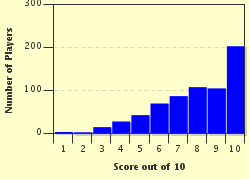Quiz Answer Key and Fun Facts
1. Norway is renowned for its fjords. Exactly what was responsible for creating them in the first place?
2. What is noteworthy about Sognefjord?
3. What is the name of the peninsula shown here, on which Norway is located?
4. With which of these countries does Norway NOT share a land border?
5. Jan Mayen is a volcanic island about 1,000 km off the coast of Norway in the North Atlantic. As you can see from this satellite image, it has two larger parts connected by an isthmus. The northern part contains the world's northernmost active surface (as opposed to submarine) volcano. What is its name?
6. The northernmost point of Norway is found in an archipelago located in the Arctic Ocean which was first settled in the 17th century as a base for an economically important industry. The collapse of what industry in the 19th century led to the temporary abandonment of Svalbard?
7. Bouvet Island is an uninhabited Norwegian dependency in the South Atlantic which is an important breeding ground for what kind of bird?
8. Norway has a sizable claim in Antarctica (although no Antarctic claims are officially recognised). What is the name they give to the region to which they lay claim?
9. This is a picture of Norway's oldest national park (although its name suggests it might be located in another nearby country), which was established in 1962 and is renowned for its reindeer. What is its name?
10. Since 1979 this dock area in Bergen has been a UNESCO Cultural Heritage site, because the buildings were an important part of the Hanseatic League. What is this region called?
Source: Author
looney_tunes
This quiz was reviewed by FunTrivia editor
Pagiedamon before going online.
Any errors found in FunTrivia content are routinely corrected through our feedback system.

